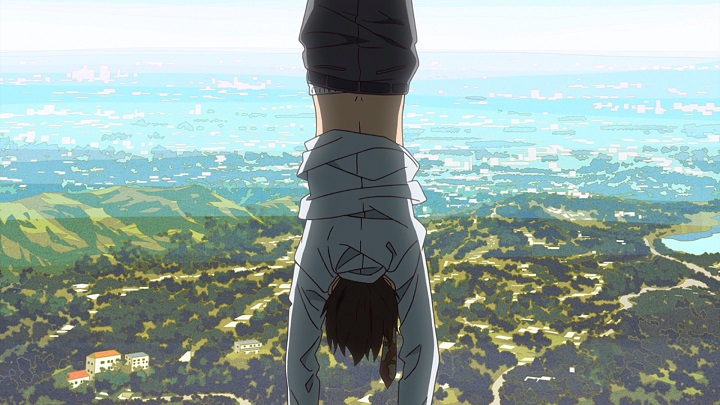From an aesthetic point of view, Great Pretender is my favorite TV anime of 2020. I’ve spoken plenty about art director Yuusuke Takeda in previous posts, but since this is the last time I’ll be writing about this show for the blog, allow me to recap: he’s one of the best and most prolific visual designers in the industry today, and Great Pretender is one of his most striking works. His brash juxtaposition of color was a great fit for such a sharp, fast-moving series – as were the angular designs of legendary character artist Yoshiyuki Sadamoto. Tasked with creating an entirely adult cast, he opted to give them prominent noses and messy hairdos, incorporating plenty of detail while still allowing the animation team room to breathe. They did their nimblest and most acrobatic work in the show’s first arc, but even as Great Pretender settled in for the long haul, it maintained a sense of liveliness sufficient to absorb you in its story.
So why the caveat that it’s my favorite only in aesthetic terms? What disqualifies it from being the runaway AOTY that I initially hoped it would be? And on the flip side, what does Great Pretender do right that most other series wouldn’t dare to attempt? Read on for one man’s thoughts on one of the year’s most original anime.
I’ll start with some praise: Great Pretender’s dialogue is the strongest part of its scripting, with playful banter and smart one-liners appearing in nearly every episode. Each character has a distinct voice that comes through in all their lines, from Laurent’s detached witticisms to Abby’s barbed insults. The breakup of Cynthia and Thomas, two of the central players in the show’s third arc, will doubtless be familiar to anyone whose once-sweet relationship has ever gone sour. The villains, too, are of the “love to hate” variety, brimming as they are with greed and malice. I still remember a conversation between a scummy businessman and the woman he bullied just before firing: “I’m deducting the time we spent talking about this from your final paycheck” was the closing line. The result of all this personality is a snappy sense of progression within each episode, which serves the show well. Great Pretender looks good and feels good to watch – but inspect its arc-based storytelling too closely, and it can start to fray at the edges.
The series’ first episode was so wonderfully assembled, with its careful foreshadowing and nonlinear structure, that I was willing to forgive some of the anime’s subsequent missteps. Factory explosions that result in zero deaths? Con artists who use their real names regardless of context? Sure, I can roll with that. As the show moved into its second arc, however, the character writing started to suffer, which is where my personal line is typically drawn. Abby’s forgiveness of a man who participated in the bombing of her homeland came as a jarring disappointment after her attempt on his life just one episode prior. In the third arc, Thomas’s motivation for breaking his “no forgeries” rule and duplicating a priceless work of art was flimsy at best. The series tried to sell it as a tribute to his former flame, but the more truthful reading is that he was badgered into it by Great Pretender’s most troubling character: Makoto Edamura.
Edamura is an odd fit for a heist series like this one, populated as it is by jaded, morally deficient criminals. He’s idealistic and impulsive, frequently deviating from whatever plan he’s given in favor of following his heart (and putting lives and livelihoods at risk in the process). I wouldn’t say it’s impossible to write a burgeoning scam artist with those traits, but you’d have to do it with a deft hand, and Edamura’s brand of nervous moralism is more sledgehammer-esque than feather-light. Thus, his turn as a double agent within a human trafficking ring in the show’s final case failed to convince me of his ability to play such a vile part. He doesn’t bear all the responsibility for the last arc’s sketchiness, though – the string of false deaths and coincidences throughout that story stretched its credibility to a breaking point. On the other hand, Laurent’s lengthy backstory was one of the show’s brightest spots, and some of the set pieces were tremendous fun. Who’s crazy enough to build a fake high-rise building on a deserted island for a simple revenge plot? The Great Pretender crew, that’s who!
In my review of the show’s concluding episodes, I said that “to machete your way through its jungle of tropes and twists with logic is to miss the point.” Given the narrative’s brisk pace and moment-to-moment sense of fun, that analogy seems to hold up – and yet, viewing the series as a whole rather than a collection of exciting highs, Great Pretender falters in too many departments to receive my unqualified recommendation. I do recommend it, however. You ought to know that the relative maturity of its cast is hampered by gaps in their emotional progression, but you should also know that it’s an excellent piece of globe-hopping visual art. Its characters and the heists they execute are entertaining, and the show’s blend of jazzy instrumentals and pop insert songs makes for a smooth listening experience. Plus, it’s a true anime original in a sea of committee-driven adaptations. There’s plenty to celebrate about Great Pretender, so give it a try if you’re still on the fence – just be prepared for some dips along the way.







You much kinder to Great Pretender in the end than I was. I… the last case, the last half of the show, was such a massive disappointment to me. The first 3 cases, loved them, but the last? It soured me on the experience personally.
It’s true that the show didn’t conclude on the strongest note, but its good looks count for a lot in my book. I get tougher on drab-looking TV anime with each passing year, so to find one that’s both attractive and unique is a huge win.
You need strong writing to back io the good looks. Great animation will only get you so far